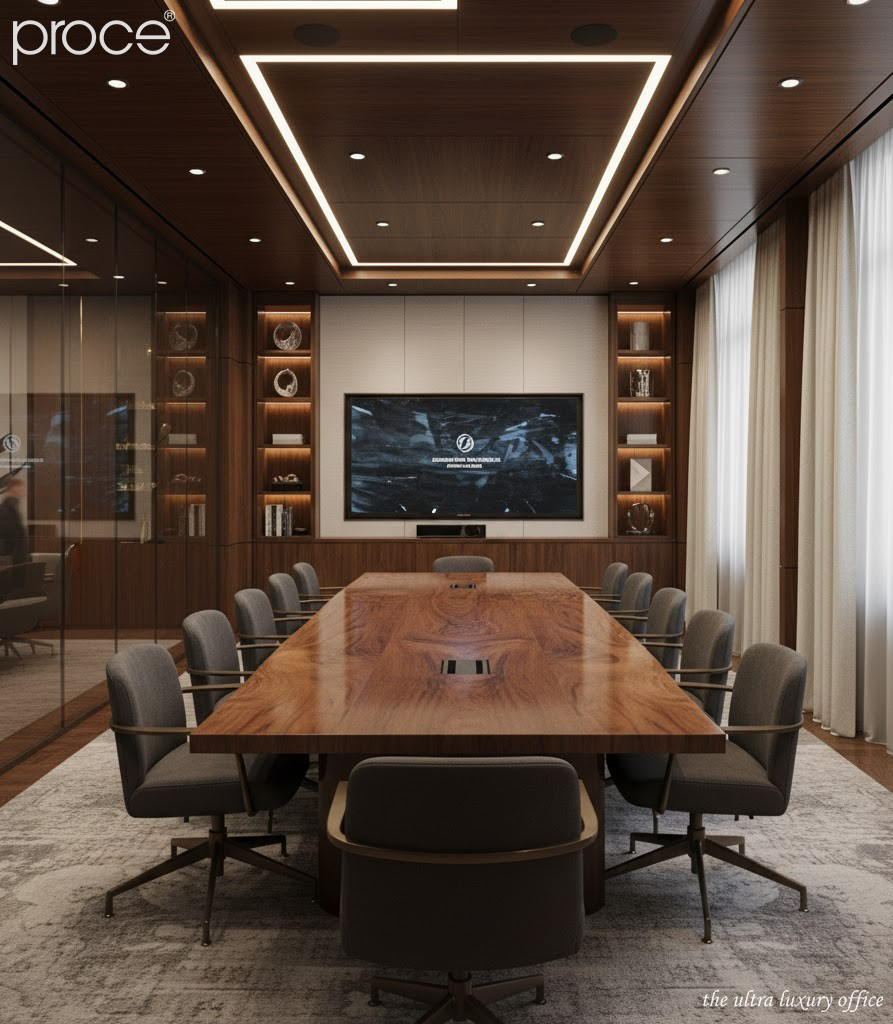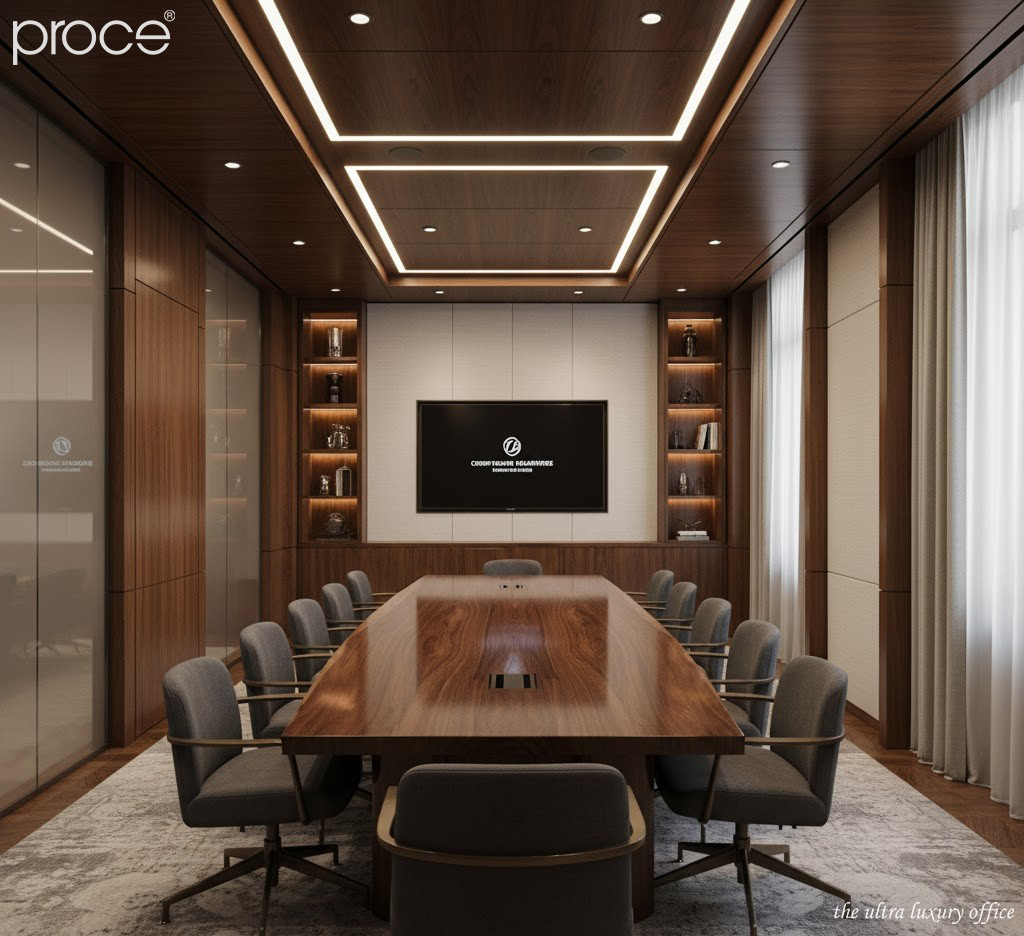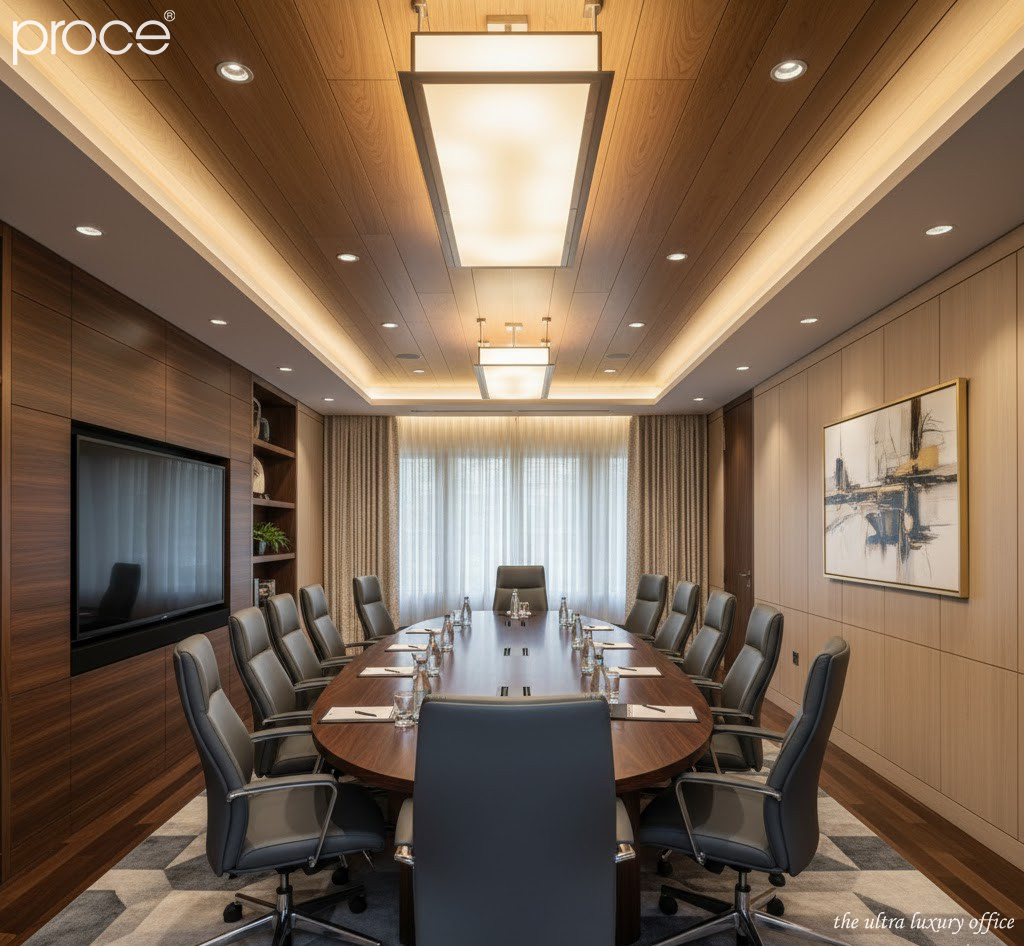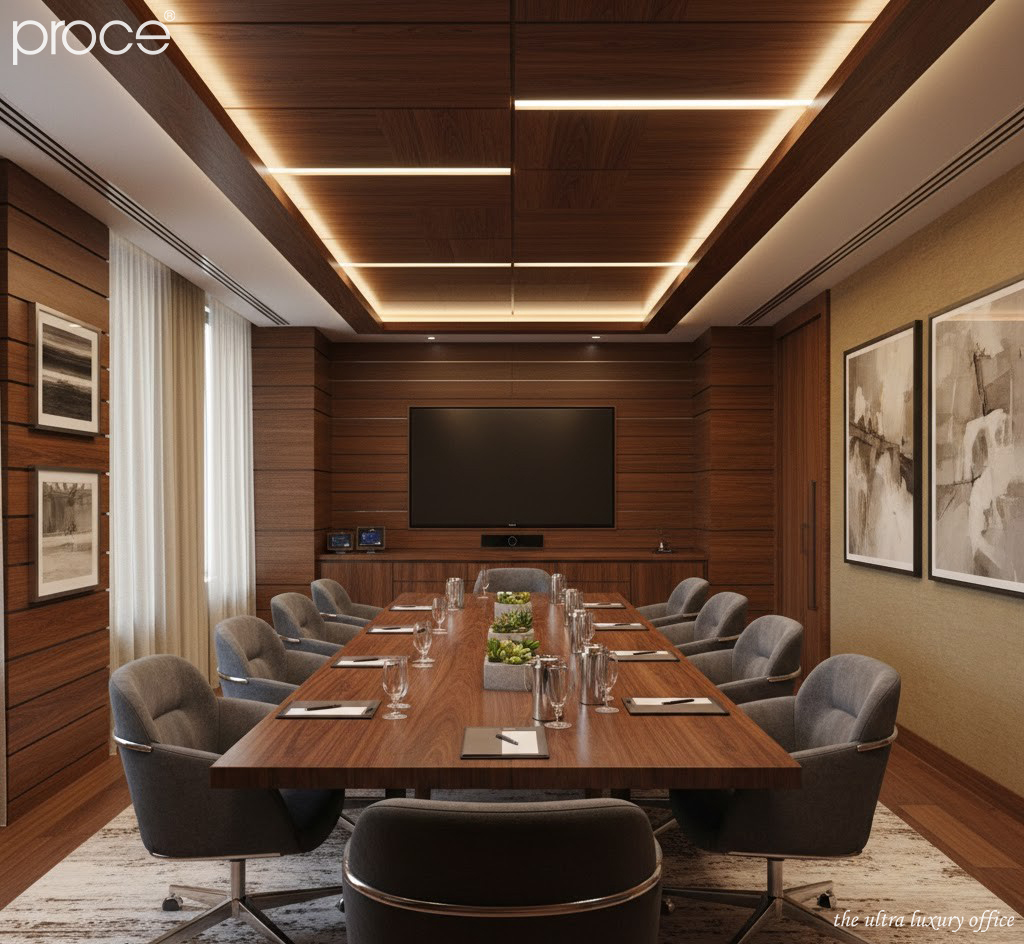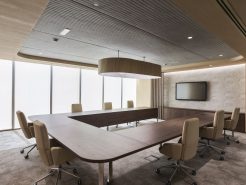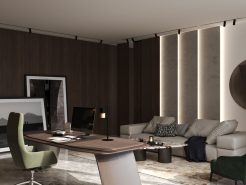In meeting room design, sound is not just a technical factor. It is part of the leadership experience. A room with a “warm” sound quality, clear and easy to listen to. Will help the meeting become more focused and inspiring. Therefore, many modern architectural experts choose low ceilings combined with wood materials as a solution that is both aesthetic and optimizes acoustics. This combination is not random. It directly affects the perception of space and the quality of communication in important decisions. So why do low ceilings and wood create a “warm” sound quality? Let’s explore from an in-depth perspective on acoustic design in leadership spaces.
1. “Warm” sound – An important factor to improve the quality of communication in the meeting room
“Warm” sound plays a key role in optimizing the listening and speaking experience. So what is “warm” sound? This type of sound is characterized by clear mid-range and bass frequencies. It helps to reproduce voices in a realistic, full and close way. In contrast to the harsh sound in the high range, “warm” sound does not cause discomfort or ear fatigue when listening for a long time. At the same time, it limits the phenomenon of reverberation, making each word clearer and more accessible. Especially in large spaces.
In the meeting room, “warm” sound brings many practical benefits. First of all, it helps listeners easily receive information even when sitting far from the speaker. The clarity and warmth of the voice also contributes to better emotional transmission. Create connections between members in the meeting. More importantly, a pleasant sound environment will reduce fatigue when having to listen continuously. And improve the ability to concentrate. Teamwork performance, quality of information exchange (President’s room interior design – Wax thread or nylon thread?).
2. The impact of low ceilings on sound quality in meeting room
In acoustic design for small and medium-sized meeting spaces. Ceiling height is a factor that directly affects the overall sound quality. One of the great advantages of low ceilings is the ability to minimize the phenomenon of reverberation. When the ceiling is closer to the speaker and listener. The distance of travel of reflected sound waves is significantly shortened. This helps to limit the situation of sound echoing or “rebounding”. Which is the cause of interference and reduces the clarity of voice during communication.
In addition, low ceilings also contribute to enhancing direct sound. That is, the sound reaches the listener’s ears without passing through too many reflective surfaces. This is very important because direct sound carries most of the content and nuances of the voice. It helps the listener feel the clarity, sharpness and naturalness in each sentence. When the sound is transmitted more clearly, the effectiveness of information communication will be higher. Especially in meetings that require precision and concentration.
In addition, in small spaces, low ceilings help control sound more effectively. The sound is not “dispersed” widely, thereby ensuring the uniformity and consistency of the sound experience for all locations in the room. This is a factor that is highly considered in modern meeting room designs.
3. Wooden material and low ceiling – The ideal duo in sound treatment for modern meeting room
The choice of materials and space structure plays a key role in shaping the sound quality. One of the optimal and highly aesthetic solutions is the combination of low ceilings and wood materials. A duo that brings outstanding acoustic efficiency, especially in small and medium-sized meeting rooms.
In terms of materials, wood is considered one of the most sound-friendly materials. Thanks to its good absorption of high frequencies and moderate reflection in the mid-bass range. Wood helps to “cut down” harsh sounds, retaining the thickness and warmth of the voice. The wooden surface, although finely crafted, often has natural grain and roughness. Creating a slight diffusion effect. Thanks to that, the sound is not concentrated or strongly reflected but spreads evenly and smoothly throughout the space.
When combined with low ceilings, wood enhances direct sound and reduces reverberation in the space. The combined effect creates an ideal acoustic space. The sound is clear, not harsh, without noise and is especially pleasant to listen to for a long time. Unlike hard materials such as glass or concrete, which reflect strong sound causing earache. Wood brings a softer, closer and more natural feeling. (The story of the round table in the conference room).
4. Why does a low ceiling combined with wood create a “warm” sound in a meeting room?
Low ceiling reduces reverberation time – Increases speech clarity
In acoustics, reverberation is the phenomenon of sound continuing to reverberate after the sound source has stopped. In meeting rooms, if the reverberation time is too long, the voice will become blurred. It will lose clarity and make it difficult to receive information. Low ceilings play a very important role in controlling this factor. When the ceiling height is lowered, the distance from the sound source to the reflecting surfaces, especially the ceiling, will be shorter. This means that the reflected sound waves will lose energy faster.
This leads to a positive result: a significant reduction in the amount of reverberation in the room. Thanks to this, the sound becomes “drier”, does not last long. And especially does not create the phenomenon of echoes causing interference. The listener feels the voice clearly, separating each word and each expression. In a professional working environment such as a meeting room. This clarity is a key factor in conveying information accurately. Does not cause fatigue when listening for a long time. It can be said that low ceilings are a natural tool to help control sound energy in space. Creating conditions for a clear, close and receptive sound field.
Wood absorbs high sound, retains mid-bass
Material is always the core factor that affects how sound interacts in a space. Wood – with special physical properties. Considered one of the optimal materials for acoustic treatment in interior spaces such as meeting rooms. Technically, wood has the ability to absorb high frequencies well. These sound ranges often cause harshness, sharpness and fatigue if not controlled. At the same time, wood gently reflects the mid and low ranges. Which is where most of the energy of the human voice is concentrated.
It is this “natural selection” that helps wood create a balanced sound environment in terms of frequency. When the high tones are softened and the mid-bass tones are retained just enough, the voice becomes thicker, deeper and sounds much “warmer” than when reflected on hard materials such as glass or concrete. This is the reason why meeting rooms treated with wood often bring a feeling of closeness, comfort and less fatigue when listening for a long time.
In addition, the wood surface is often not completely smooth. But has natural grain, groove or roughness. Creates a soft sound diffusion effect. The sound is not strongly reflected in a certain direction but spreads evenly in space. Helps listeners in many different locations to have a consistent, high-quality sound experience.
Combination of low ceiling and wood – Creates a close, clear and deep soundstage
The truly outstanding acoustic effect appears when low ceilings and wood materials are harmoniously combined in the same space. Low ceilings play a role in controlling sound energy. Reducing reverberation time, limiting echoes, creating a dry, clear and close sound field. Meanwhile, wood handles the frequency aspect. Helping the sound become more balanced, avoiding the cold or “harsh” situation due to too much high range. At the same time, adding thickness and warmth to the voice.
When these two elements are present together, they create an ideal environment for effective communication. The listener feels the voice directly, sharply but not harshly. Each word becomes easy to understand, easy to receive even in long meetings. Or when sitting far away from the speaker. Moreover, the sound spreads softly and evenly throughout the room thanks to the gentle diffusion of the wooden surface. While the phenomenon of echo or distortion is minimized thanks to the optimized ceiling distance.
The result is a clear, pleasant and “warm” soundstage. Not only in terms of sound technology, but also in the way the listener feels. That is the sophistication of modern acoustic processing. Not only achieving clarity, but also touching on comfort, naturalness and closeness. Invisible factors but deeply affecting the effectiveness of communication and work. (Unboxing 4 million dollar meeting rooms of Proce).
Conclude
When it comes to the interior design of the president’s office, we are not only talking about aesthetics or functionality. It is also about the emotional experience and sophistication in every detail, including the sound. Low ceilings help control the sound reverberation. Meanwhile, wood materials adjust the frequency range, bringing a warm, intimate but still powerful sound quality. This is both a design choice and a strategy to fine-tune the space to serve effective communication and decision-making. A “good listening” meeting room is the foundation for quality conversations. And that is why experts today prioritize the acoustic factor in the design of senior leadership rooms.
=====\
PROCE – TOTAL LUXURY OFFICE SOLUTION
Website: https://proce.vn/
Youtube: https://www.youtube.com/@noithatvanphonghangsang
Fanpage: https://www.facebook.com/vanphongnhapkhauProce
GG Business: https://business.google.com/dashboard/l/15115233216900975876
Linkedin: https://www.linkedin.com/company/74359718/admin/
Hotline: 090.115.6767
#phong_hop; #phong_hop_phong_chu_tich; #phong_hop_dang_cap
#phong_hop_chuan_sang; #noi_that_phong_hop; #thiet_ke_phong_hop
#phong_hop_chu_tich_cao_cap


